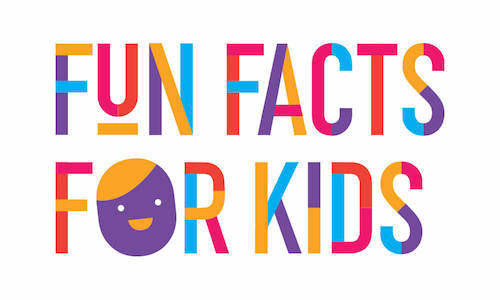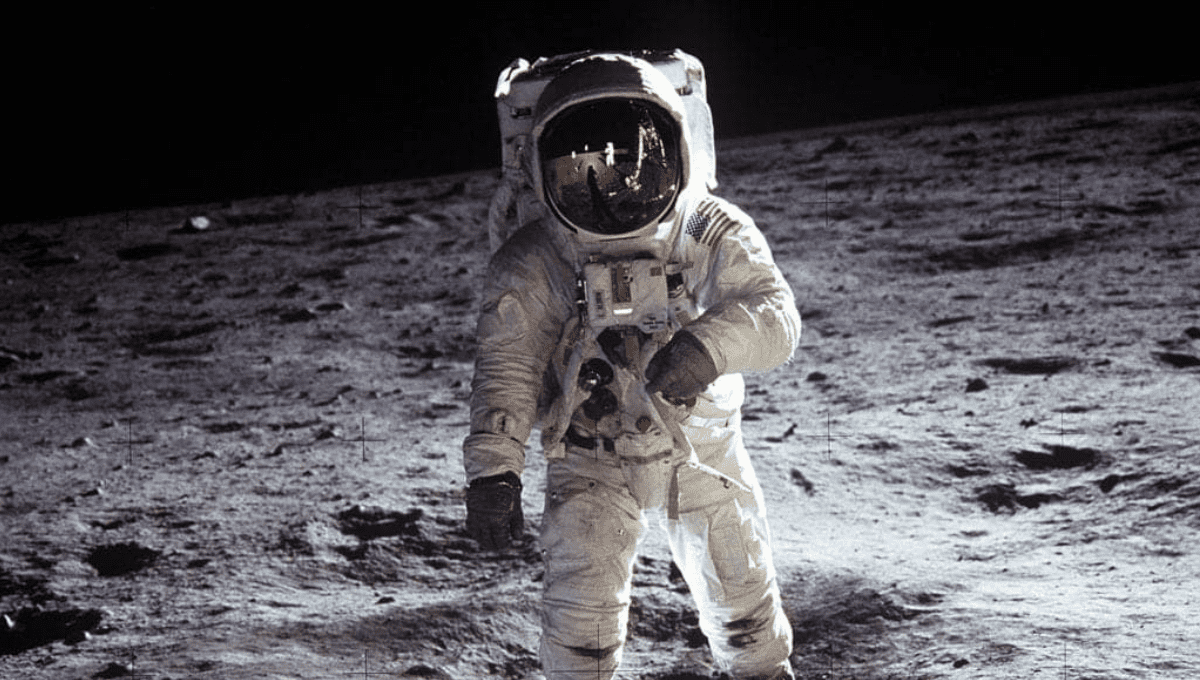On July 20, 2019, we celebrated the 50th anniversary of the first moon landing. Here are some fascinating moon landing facts for kids.
Why did people go to the Moon?
Great question!
The Great Space Race
The journey that took humans to the Moon is often thought of as the great space race. The United States of America and the Soviet Union of Russia were contending to be the first to land people on the Moon. Russia was the first country to successfully launch a person into space when Yuri Alekseyevich Gagarin orbited the Earth on April 12, 1961. His entire journey around the Earth’s circumference took only one hour and 48 minutes, during which Yuri spoke the words “Flight is proceeding normally; I am well”
The United States of America had planned to send their man into space in May 1961, and it was a great disappointment to the US President to learn that Russia had got there first, and by just one month. Not to be bested, President John F Kennedy declared “I believe that this nation should commit itself to achieving the goal, before the decade is out, of landing a man on the Moon and returning him safely to Earth”. The goal was achieved on July 20, 1969 – just within the decade! To date, America is the only country to have sent people to the moon.
A spacecraft fit for the journey

Image credit: NASA – Launch of Apollo 11
The journey to the Moon was to be made in a large spacecraft under the mission name Apollo 11. The spacecraft was comprised of three main parts; a ‘Saturn V’ rocket to provide the necessary thrust to leave the Earth’s atmosphere, the Command Module, called Columbia, in which the astronauts lived, and a Lunar Module, called Eagle, for the actual landing.
The Command Module
The Command Module had just enough room for the astronauts to move around, sleep, eat and go to the bathroom in, and it was designed for a crew of three. One person would stay aboard the Apollo Command Module for the whole duration, and two astronauts would travel to the Moon’s surface in the Eagle
The Eagle
The lunar module Eagle was a small craft by space travel standards. It stood 5.5 metres tall and weighed 14,969 kg – that’s about as tall as a giraffe and as heavy as three elephants. Most of that space was taken up with storage containers, engines, and all the technical equipment required to make and broadcast the journey. There was very little space left for the astronauts themselves, but the astronauts had just enough room to eat a small meal before going out onto the Moon’s surface. They were also supposed to have a little sleep, but excitement got the better of them and they asked if they could go out early!
What was the Apollo 11 mission?
The primary mission of Apollo 11 was to prove that it was possible to land a crewed spacecraft on the Moon and safely return to Earth – ideally before any other nation did! Additionally, if possible, the crew were to collect samples of ‘moon dust’, analyse wind, light and seismic patterns, take photographs, and record it all on a television camera to beam all the excitement back to everyone watching on Earth.
To learn even more about apollo 11, check out this range of books.
Who was on board the Apollo 11 mission?
Three astronauts were on board the Apollo 11 mission:
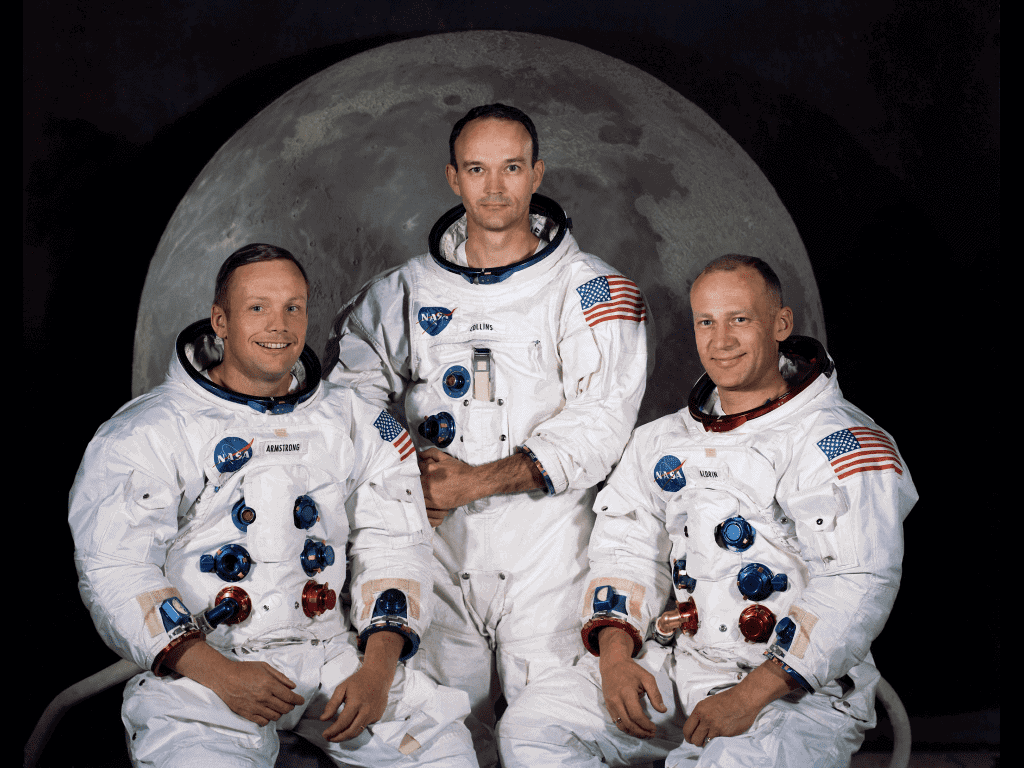
The Apollo 11 lunar landing mission crew, pictured from left to right, Neil A. Armstrong, commander; Michael Collins, command module pilot; and Edwin E. Aldrin Jr., lunar module pilot. Image Credit: NASA
Lieutenant Colonel Michael Collins
Michael Collins was the Command Module Pilot. He was born in Rome on October 30, 1930 and flew jet fighters and experimental planes for the United States Air Force. He became an astronaut in 1963. Michael Collins stayed aboard the Apollo 11, maintaining a steady orbit above the Moon’s surface whilst the other two astronauts landed.
Colonel Edwin E. “Buzz” Aldrin Jr
Buzz Aldrin was born on Jan 20, 1930 in New Jersey. He flew combat missions for the US Air Force in the Korean War and became an astronaut in 1930. His role on the Apollo 11 mission was ‘Lunar Module Pilot’. Buzz piloted the Eagle.
Commander Neil A. Armstrong
Neil Armstrong was Mission Commander of Apollo 11. He was born on August 5, 1930 in Ohio. He flew combat missions for the United States Navy before becoming an astronaut in 1962. Neil Armstrong was the first human ever to set foot on the Moon – or any other celestial body other than Earth
The back-up crew
In case any of the three main crew became ill or couldn’t make the journey, three other astronauts trained with them, ready to step into their roles if required. The backup crew were James A. Lovell, Commander, Fred W. Haise Jr., Lunar Module Pilot, William A. Anders, Command Module Pilot.
The journey to the Moon
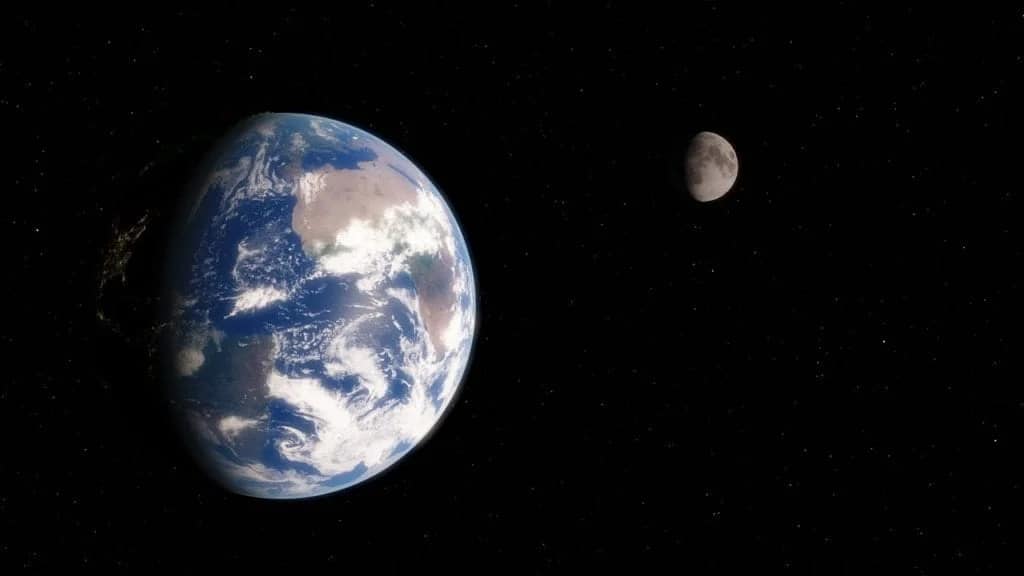
Travel to the Moon took a little over 3 days. Apollo 11 launched at 9:32am on July 16, 1969 and reached the Moon’s orbit on July 19. The spacecraft orbited the Moon waiting for the right time to send down the Eagle. The landing was to be made at a time when the Sun was rising over the lunar landing site so that the long shadows it cast would help the astronauts to identify surface landmarks – the astronauts didn’t want to land in a crater! The landing site chosen was called the Sea of Tranquility.
Get these amazing moon stickers to embellish your project!
What did the astronauts see?
When Apollo 11 arrived in lunar orbit, Michael Collins thought, “The Moon I have known all my life, that two- dimensional small yellow disk in the sky, has gone away somewhere, to be replaced by the most awesome sphere I have ever seen. To begin with, it is huge, completely filling our window. Second, it is three-dimensional. The belly of it bulges out toward us in such a pronounced fashion that I almost feel I can reach out and touch it.“
The astronauts also saw the far side of the Moon as they travelled around it. On Earth we only ever see one side of the Moon because the Moon rotates on its axis at exactly the same speed as it orbits the Earth. Take a look at the spots and patterns that you can see on the Moon – they will always be in the same place. The far side of the Moon is also called the dark side, but it’s really no darker than the side we can see.
What did the astronauts do?
Most of the journey to the Moon was spent in routine maintenance of the spacecraft and its course, but on the second day of flight the crew filmed a 36 minute television segment – in colour – to be broadcast back home. It’s hard to believe that men were on their way to the Moon in a spaceship, and yet colour TV was relatively new. Those who could afford to bought colour televisions in anticipation of seeing the Moon landing broadcast in full colour, but the landing was only broadcast in black and white.
The Eagle has landed
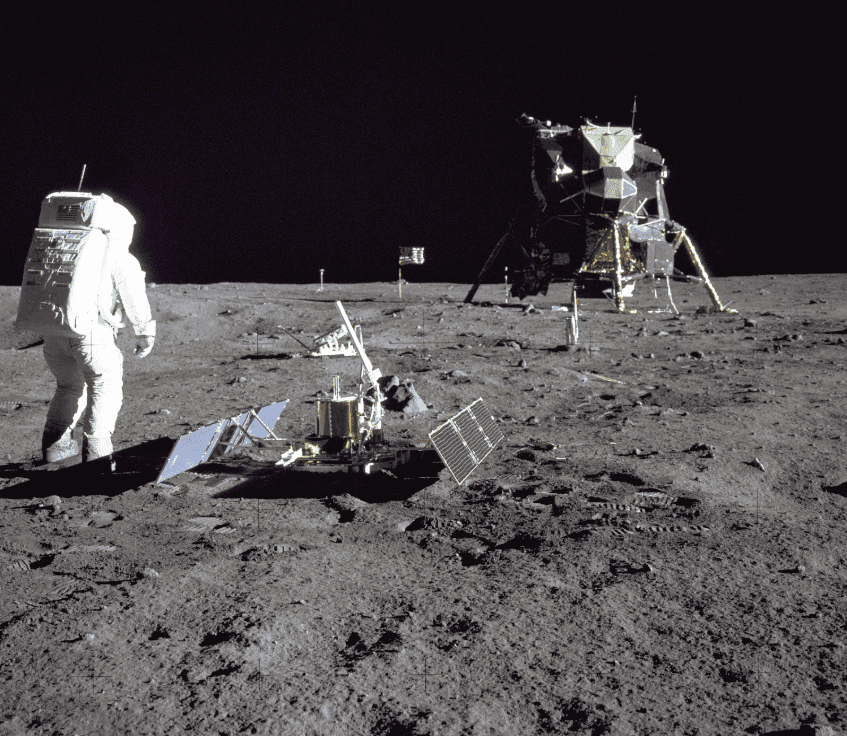
Image credit: NASA – Buzz Aldrin and Eagle
The Eagle was launched from Apollo 11 and landed on the Moon on July 20. Upon landing, Neil Armstrong notified the team back on Earth with the now historic words, “Houston, Tranquility Base here. The Eagle has landed.”
For two hours Armstrong and Aldrin stayed aboard the Eagle to prepare themselves and have a bite to eat. Then Neil Armstrong opened the door, climbed down the ladder, and became the first person ever to set foot on a celestial body outside Earth. When the door opened it triggered a camera outside the Eagle to start broadcasting back to the 600 million people watching the action unfold live on Earth. Armstrong said, “That’s one small step for man, one giant leap for mankind.”
Buzz Aldrin became the second man on the Moon approximately 20 minutes later. Because Neil Armstrong had the camera, most of the photos of the “man on the Moon” are of Buzz Aldrin, except for the video stills from the Eagle’s camera.
What was it like on the Moon?
The gravity on the Moon is about one-sixth that on the Earth and both astronauts found it very easy to bounce and move around.
The surface is very dusty and dry, with lots of craters from asteroid impact, mountains, deep canyons and ancient lakes of cooled-down lava. You can see these from Earth as the shadows and dark patches on the Moon’s face.
The Moon is also very hot – over 100 degrees Celsius! The astronauts wore water-cooled spacesuits so they didn’t go too far in case the cooling system failed. At night on the Moon the temperature drops to minus 150 degrees Celsius.
What could the astronauts see from the Moon?
The astronauts could see the Earth. It was so far away that they could blot out the view with their thumbs.
What did the astronauts do on the Moon?
Neil Armstrong and Buzz Aldrin explored the Moon’s surface outside the Eagle for about two and half hours. First they made sure everything was ready to go again in case they needed to make a quick exit, then they collected samples of lunar soil and rock, took lots of photographs and, erected a United States flag. They spoke with U.S. President Richard Nixon, whose voice was transmitted from the White House, and placed a plaque on the ground that stated:
HERE MEN FROM THE PLANET EARTH
FIRST SET FOOT UPON THE MOON
JULY 1969, A.D.
WE CAME IN PEACE FOR ALL MANKIND
They also laid down memorial medallions of other space explorers and a small disc with goodwill messages from 73 countries, and the names of United States congressional and NASA (National Aeronautics and Space Administration) leaders inscribed in microscopic text.
The two astronauts took off from the Moon’s surface in the Eagle around 21 hours after they landed. After transferring everything they had collected into the Columbia (Command Module), the Eagle was jettisoned into space, where it remains in the Earth’s orbit as space junk.
Everything those first men left on the moon – including their footprints – is still there.
Check out these awesome astronaut posters for kids!
Getting home again
It wasn’t easy to land a big spacecraft back on Earth, so the Columbia made a planned splash landing in the Pacific Ocean on July 24. Nobody knew if there were harmful bacteria or viruses on the Moon, so the astronauts put on protective hazard suits before being picked up by the recovery ship, USS Hornet. The crew were rubbed down with iodine to prevent infection and then transferred into quarantine back at Houston, where they remained until given the all-clear on August 10.
What was the Moon landing like for people on Earth?
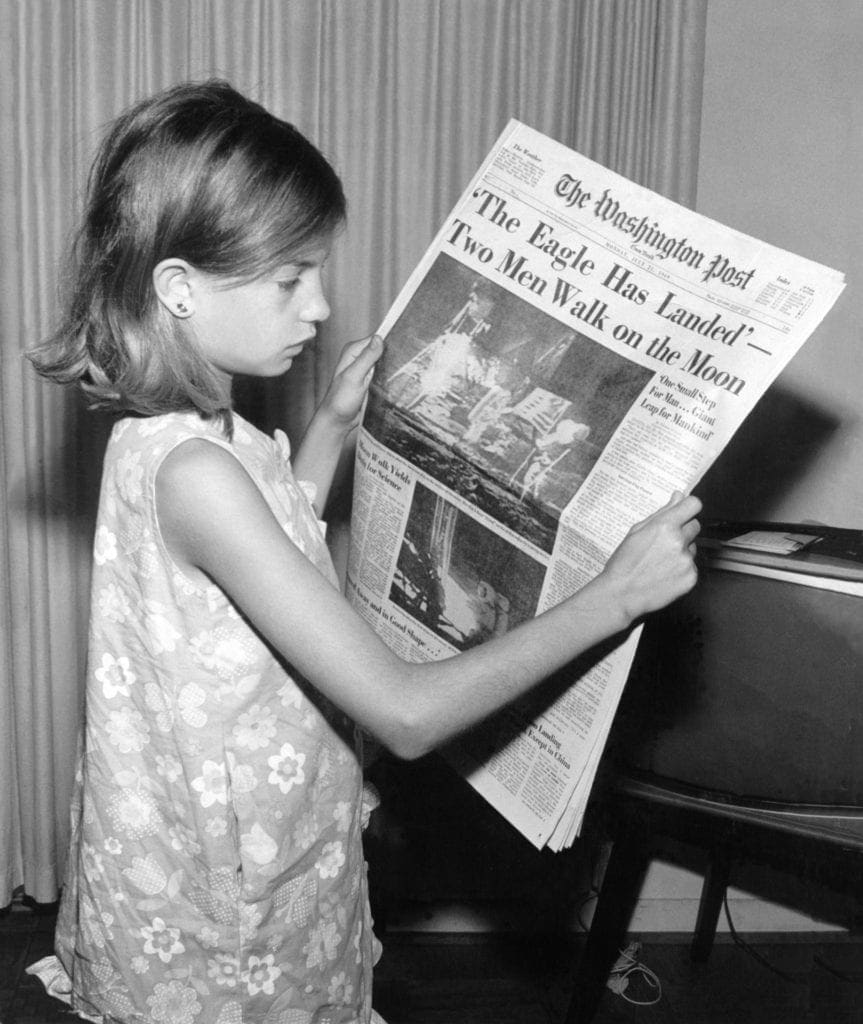
An estimated 600 million people on Earth watched the Moon landing, and celebrated when Neil Armstrong took his first steps on the Moon. It was an incredibly exciting time, and everything seemed possible. Not everyone owned a television, but those who did invited neighbours around to watch on theirs. The Moon landing brought communities together to share the excitement of the historic occasion.
In Brisbane it was just before 1pm when Neil Armstrong stepped out onto the Moon. In schools across Australia, children gathered together to watch on classroom televisions. People stopped work and listened on the radio if they didn’t have access to a television. Ask your grandparents and great-grandparents if they remember what they were doing when man first walked on the Moon.
In the UK it was almost 4am, and children stayed up all night to watch, or were woke by their parents just in time to see. It was the first ever all-night broadcast on UK television.
In America, the first steps on the Moon took place late in the evening (almost 11pm New York time, 8pm California time). Many people made a great event of the landing and celebrated with Moon parties.
Back then, people thought humans would be living on the moon by now!
Who made the mission possible?
Men were the first to walk on the Moon, but it was a woman that got them there.
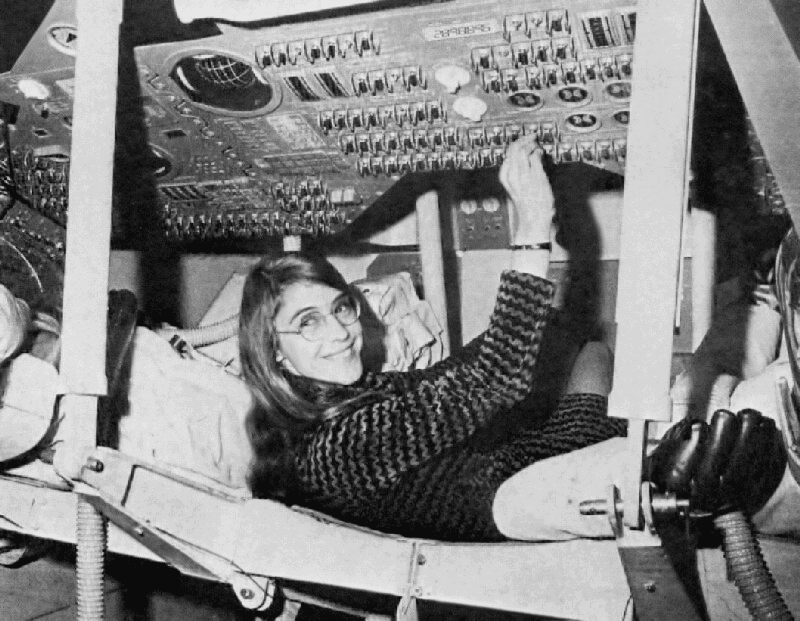
Image credit: NASA – Margaret Hamilton
Margaret Hamilton, born in 1936, was a very talented mathematician and engineer. She became the director and supervisor of the software programming for the Apollo projects. During the flight to the Moon, several alarms sounded that might have caused the mission to be aborted, but the problem was caused by an incorrectly activated switch, and Hamilton’s software was able to overwrite and correct the problem, thus saving the mission!
Who made the Moon landing broadcast possible?
Well, Australia actually played a pretty big part in that. At Honeysuckle Creek near Canberra, the Parkes radio telescope and a NASA antenna were part of a relay or similar devices all around the world set to capture and broadcast the Moon landing. After only 8 minutes, NASA chose the Canberra Parkes radio telescope to have the honour of being the sole broadcaster of the entire remaining 2 hours and 12 minutes of Moon exploration to the rest of Earth. A movie, called The Dish, was made of Honeysuckle Creek’s involvement – it wasn’t all plain sailing and nearly failed! The CSIRO website has more information on Australia’s involvement in the Apollo 11 Moon landing.
Has anyone ever been back to the Moon?
Yes! Before the Moon landing there were four crewed flights that flew to the Moon’s orbit to test the equipment; Apollo 7 and 8 in 1968, and Apollo 9 and 10 in 1969. None of the three Apollo 11 astronauts were on board for those flights. In fact, Apollo 11 was Collins’, Aldrin’s and Armstrong’s only lunar journey.
People went back to the Moon on Apollo 12 in Nov 1969, Apollo 14 and Apollo 15 in 1971, and Apollo 16 and 17 in 1972. That was the last time humans went to the Moon, and no one ever went twice. Apollo 13 went to the Moon in 1970 but couldn’t land because of a malfunction. Luckily all three astronauts made it safely back to Earth. All up, only 12 people have ever had the amazing experience of walking on the Moon.
Will anyone ever go to the Moon again?
Possibly, but the next destination is MARS!
The space race is on again to be the first nation to send people to Mars, and it could happen as early as 2030.
How do you get to be an astronaut?
To be an astronaut for NASA, the basic requirements are a bachelor’s degree in engineering, biological science, physical science, computer science or mathematics, followed by three years of professional experience (or 1,000 hours of pilot-in-command time in jet aircraft). Candidates must also pass NASA’s astronaut physical examination.
We love these books about astronauts for kids!
Where can you learn more about the Moon landing and space travel?
Until October 19, 2019, you could discover lots of amazing things about space travel at Queensland Museum. “NASA – A Human Adventure” is the most comprehensive and extensive touring space flight exhibition in the world. The objects on display include original space flown objects, high fidelity replicas and scale models. This exhibition has now closed.
NASA also has lots of facts and information just for kids in the NASA Kid’s Club. The NASA Kid’s Club has heaps of interactive learning activities tailored to kids of all ages.
How do you think you would have felt to be the first person on the Moon?
Do you think you would have been excited, and awestruck? Would your heart have been racing? Would you have been worried about floating away or meeting aliens? Neil Armstrong said the most exciting part was landing the Eagle and knowing that humans had finally touched the Moon. As for the rest, he was too focussed on completing his mission objectives!
Fun Moon facts
- The gravity on the Moon is about one-sixth that on Earth, meaning that if you weigh 60kg on Earth, you would only weigh 10kg on the Moon!
- The Moon is about 1/4 the size of Earth
- Earth’s moon is the fifth largest moon in our solar system
- The distance to the Moon is around 385,000km, but because the orbit isn’t entirely round, that varies depending on the day you travel
- The Moon moves approximately 4cm further away from Earth every year, but it will be millions of years before the effect is felt on Earth.
- The Moon has no weather. It looks exactly the same all year round, and that’s why all the footprints haven’t blown away.
- The highest mountain on the Moon is Mons Huygens. It is 4700 metres tall – just over half the height of Mt Everest (8848m).
Check out these great moon books for kids!
Other articles you might enjoy

Is you child inspired by outer space? Check out our Super Moon Guide and our Kids Guide to the International Space Station!
You can find lots more interesting articles under our Space tab.
More facts for kids
If you are looking for more great facts for kids to help with projects, check out our articles:
